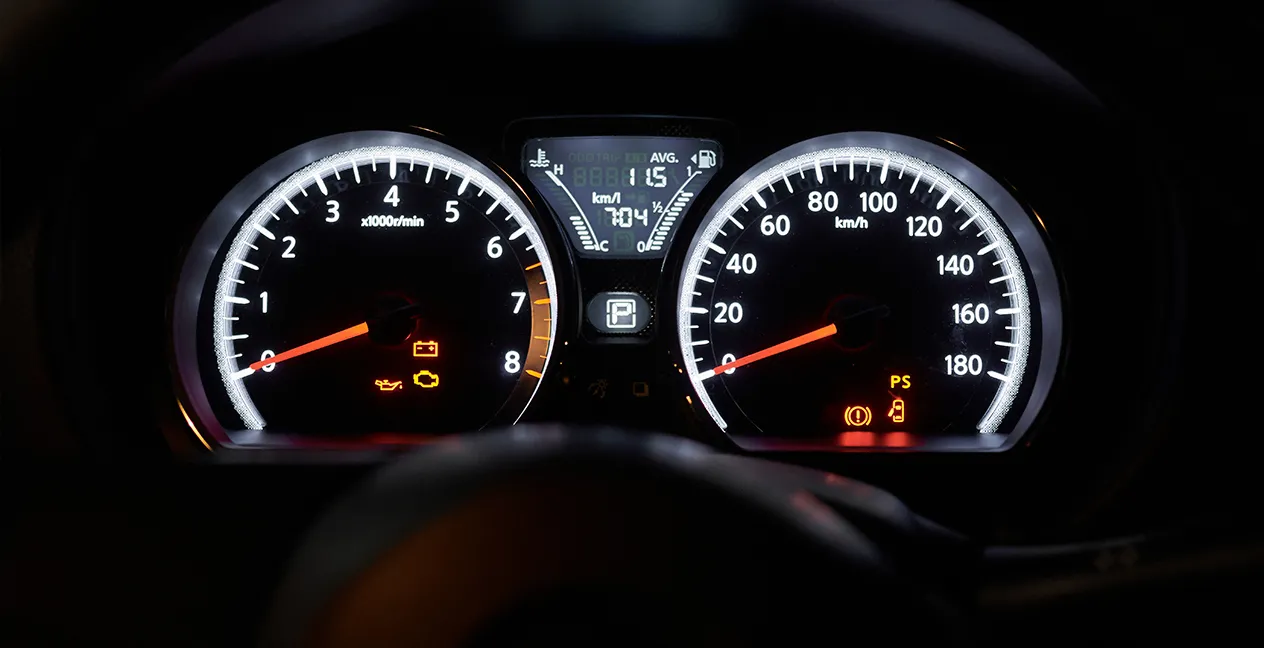
Created by Ana Faustino at Thursday, 19 May 2022
What do the dashboard lights mean?
The instrument panel lights are designed to alert the driver to possible faults or anomalies in the vehicle.
First of all, know that the color of the light you see will indicate the level of attention you should pay to the warning. Therefore, green, blue or white lights are merely informative and do not require any action on the part of the driver. Yellow lights require attention, but do not imply that the car must be stopped immediately. Red lights indicate the need for an immediate visit to the mechanic and, in most cases, the best course of action is to immobilize the car and call a tow truck.
.
Learn the meaning of the most important and common lights on your car:
 .
.
.
1 - Handbrake - This is the light that indicates that the handbrake is applied. If it stays on when the handbrake is released, there may be a problem with the braking system, especially a lack of fluid in the reservoir. In this case, you should top up the fluid and see a mechanic, as the fluid only goes down if there is a leak. In some cars, there is a specific light for the fluid.
.
2 - Injection - This is the electronic injection light, which should go out after starting. If it stays on while the engine is running, it indicates a fault in the emissions control system. If it keeps flashing, it indicates a fault that could lead to damage to the catalytic converter. In both cases, slow down and call a garage.
.
3 - Alternator - The red light should turn off a few seconds after the car is running. If it stays on, the battery is not charging. Engine cooling may be interrupted and the brake assist unit may no longer be effective.
.
4 - Pre-ignition - When it stays on, it means that the diesel engine's pre-heating is activated, which only happens when the outside temperature is low. If it flashes, the engine preheating is faulty.
.
5 - Automatic transmission - Only illuminates when the vehicle is started, to remind the driver that they need to step on the brake to put the car into Drive. In many cars the warning is given on the multimedia screen or another part of the dashboard.
.
6 - Anti-lock braking system (ABS) - Indicates possible faults in the ABS system or ESP (traction and stability control, which acts with the aid of the brakes). The problem in this case could be with sensors, the hydraulic system or even the control unit. If they stop working, the vehicle starts to operate with conventional brakes.
.
7 - Rear defogger - The defogger works on the rear window and is usually represented by a yellow light on the dashboard, which comes on when the equipment is activated (on many models the light can be on the central panel, usually on the control button itself).
.
8 - Airbag - This lights up when there are signs of a fault in the airbag system and belt pretensioners, which may not work in the event of an accident. In this case, it is recommended that an authorized workshop is sought immediately. In some vehicles the airbag light is yellow (warning only).
.
9 - Tire pressure monitoring system - If this light remains on after starting the engine, one or more tires must be significantly underinflated compared to the manufacturer's recommendations. The solution is to stop immediately and check the tire pressure.
.
10 - Light control system - In most cars this design appears as standard to indicate a light that has burned out or is unsuitable for the car's system.
.
11 - Headlights (low beam) - Indicates that the car's headlights are on low beam.
.
12 - Headlights (high beam) - Indicates that the car's headlights are on high beam.
.
13 - Rear fog light - Illuminates when this headlight is on, usually as a single, intense light on one side of the rear lamp. This light is very important on rainy and foggy days, to make it easier to see drivers coming up behind.
.
14 - Front fog light - This lights up when this headlight is on. It is recommended for rainy and foggy days (when the brightness is low), to increase peripheral vision.
.
15 - Seat belt - Alerts the driver and/or other passengers to the need to wear a seat belt.
.
16 - Immobilizer - Indicates malfunctions in the immobilizer system, possibly caused by problems with the key chip, the ignition system itself, the electronic injection module or the electrical cables. It may be accompanied by the name "code".
.
17 - Maximum attention light - This is the symbol for a vehicle's main emergency light. If it is on, there will probably be other information on the dashboard. It can indicate serious problems, such as low oil pressure, open doors, a vehicle with no battery, among others. Despite the importance of this warning, in some vehicles its light is yellow (warning only).
.
18 - Ramp Start Assist - Known as HLA, it should only come on when the engine is started, along with the other lights. The system remains active at all times, works on slopes and inclines, but the light does not flash or reignite during operation.
.
19 - Cruise control - Lights up when the cruise control is initiated by the driver. In some vehicles, it may be represented by the word "Cruise". When the system is adaptive (it adjusts to the vehicle ahead), it is common to see a drawing of a small car above the speedometer.
.
20 - EPC (Engine Power Control) - This light is usually associated with Volkswagen cars. The EPC indicates an anomaly in the Engine Power Control. Ideally, take the car to a specialist workshop where the car's electronic controls can be read.
.
21 - Refueling light - Alerts the driver that the fuel level is low. You should refuel the car as soon as possible and never let the tank run completely empty.
.
22 - Power steering system - Less common than the other red lights, this signal indicates faults in the power steering system (electric, hydraulic). In some vehicles it may be yellow (warning).
.
23 - Overhaul - This tool, flashing on the dashboard (ignition only), indicates that it is time for a regular check-up, according to the overhaul program in the manual (the schedule is set at the dealership). It can use other symbols, such as the word "Service" or "INSP", for "Inspection".
.
24 - "Eco" function - In order to improve fuel consumption, many cars "tell" you when you are driving economically. An indicator is shown on the dashboard, usually with the word "Eco", but also with "ecological" symbols, such as trees, or a plus sign ("+") etc.
.
25 - Center differential lock - Vehicles that have a center differential lock have this symbol on the instrument panel, which turns on when the vehicle is started and when the lock is applied, usually in off-road situations. When the differential is rear, the "X" is positioned on the rear axle of the design. In some vehicles the "X" is replaced by the word "Lock".
.
26 - 4x4 - In vehicles with four-wheel drive, this light (or a 4x4) appears on the dashboard from the moment the system is activated. In some cases, when the car is already in 4x4 and the reduced gear is activated, the symbol has the word "Low" below the 4WD (or 4x4).
.
27 - Stability control - If this light comes on and stays on while the car is moving, there are two possibilities: the electronic stability control system (usually called ESP) has been switched off or has suffered a fault, which will cause it to remain deactivated until it is checked. When it flashes (but without the word "off") on the dashboard during strong maneuvers, it simply means that the system is working.
.
28 - Cold start reservoir fill light - Generally far away from the pointer marking the normal fuel tank, and accompanied by the letter "G" or the name "GASOLINE", this indicates a relatively low level in the cold start tank in hybrid cars.
.
29 - Coolant temperature - Indicates possible or imminent overheating of the engine. It can light up due to a lack of coolant, faults in the ventilation systems or sensors.
.
30 - Oil light - This is related to a problem with the oil pressure, engine lubrication or oil switch. Ideally, stop the car immediately when this light comes on.
.
.
.
Source: sedecar.com.br
Translated with DeepL.com






